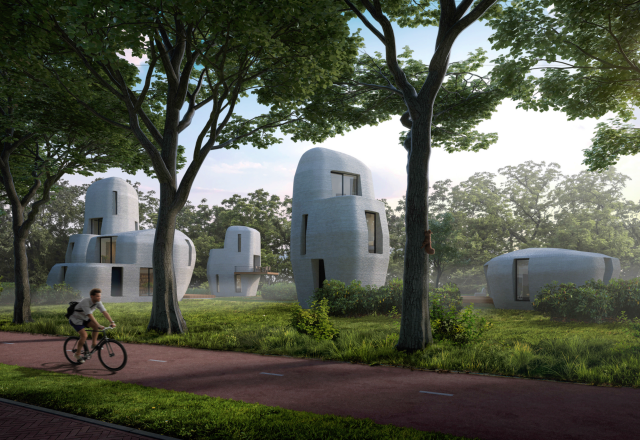Will printers build the homes of tomorrow?


The robots shaping the future of buildings

It is a new technology which allows you to do things which you could not in traditional ways. It will be a production method of the future not the production method of the future.
Consider the humble office printer. Bulky, loud and occasionally unreliable. It doesn’t seem like it’s about to transform construction. But where an office printer takes a digital 2D document and makes it physical, a 3D printer can take a digital design and using a material, ‘print’ it as a physical object.
3D printing is already making an impact in the manufacturing sector, acting as a technological link between the worlds of digital design and physical products. Toys, shoes and airplane parts, are already being made using the much-hyped technology.
But what if it could be scaled up to printing entire buildings?
That’s exactly what Saint-Gobain Weber Beamix aims to do. Through a partnership with Eindhoven University of Technology, Project Milestone, the team plans to construct five houses in the city using the technology, making them available to rent from the first quarter of 2020.
Is this the start of a construction revolution that will lead to a future of 3D printed cities? But to understand how you print a city worth of buildings you first need to understand how you print one.
How do you 3D print a house?
The machinery needed to print a house is a step beyond a standard 3D printer. Marco Vonk, Marketing Manager of Saint-Gobain Benelux, describes the machines as looking like, “a junction between a welding robot in the car industry and plastics 3D printers.”
The result is a large automated arm that maneuvers a hose, laying layer over layer of concrete, in a shape exactly replicating a digital design.
However, developing 3D house printing isn’t as simple as inventing the machinery to print in concrete. An even greater challenges for Weber Beamix to overcome in making 3D printed construction a reality was cracking the concrete code.
“There are two routes,” explains Marco Vonk. “You either use very fast-setting concrete, where the first layer sets quickly enough to support the second layer or you use a mortar, which remains a fluid so long as it is moving, but when it’s put on the ground it will set enough to carry the next layer. We choose and optimized the second route, with the big advantage that can we create objects now that are made of monolithic high strength concrete (as if they were casted!)”.
Combining automation and robotics with this unique mortar opens up a new frontier for architectural designs, in closing the gap between a digital idea and a real world house.
Can a robot arm make buildings more creative?
Perfectly smooth, rounded corners, long weaving walls and 3D shapes that curve in one direction then in the opposite are hugely difficult, if not impossible to make in concrete using traditional methods. However, when there’s a robotic arm applying concrete rather a human, then it can follow the exact digital guidelines of an architect’s design. It makes almost anything possible.
“Architects are given more freedom – it’s a complete new way of thinking,” says Marco Vonk. Bringing the physical construction of houses closer to the digital not only opens up creative avenues, but new efficiency and sustainability possibilities too.
Nature-inspired sustainability
Marco Vonk points to Barcelona’s Sagrada Familia – Antoni Gaudí masterpiece cathedral – as a point of comparison. The building isn’t 3D printed (it’s closer to hand-carved) but it’s pillars and arches are inspired by nature, where trees and plants only use the materials necessary for the them to grow, and only when need, without the inefficiencies of human building construction. This efficient use of a little material as possible is known as topological optimization.
3D printing makes this achievable in human environments, creating shapes and elements of houses using a single substance, without requiring additional material such as formwork – where molds are built to pour concrete into before being removed once it’s set.
Print-building… anything?
But can we literally print-build anything, in any shape, any height or aesthetic subtleties? “In theory a lot, perhaps everything is possible”, says Marco Vonk, “But we just opened this box of possibilities and Newton’s 1st law (of gravity) remains valid at all time! So there will be a lot of future challenges to be discovered and conquered…”
Another obstacle to the development of 3D printed houses, in Europe at least, is the regulations governing the construction of housing. 3D printing does not yet fully meet these requirements.
Using humans… more efficiently
The automated nature of the process also uses labor more efficiently. Using 3D printing, humans are able to focus on the intricate tasks of plumbing and wiring houses, leaving time consuming wall construction to their robotic colleague.
Reducing human hands in the process also reduces the room for errors and breakages that will eventually require further materials and expenses. However, Marco Vonk is confident that the technology will serve to both cover human labor shortages and create new, skilled jobs in other parts of the construction process.
It’s clear the technological challenge has been tackled, but does it work at scale? Will the suburbs of the future be 3D printed?
A 3D printed future?
3D printing offers the possibility of more efficient, sustainable constructions, but for the foreseeable future Marco Vonk believes 3D printing will remain an addition to traditional construction methods, rather than a truly disruptive force.
At present, the heavy complex nature of the printing machinery means the actual 3D printing takes place in a factory or workshop. In Project Milestone, for example, robotic arms print elements of each house, which are then transported by road to their location to be constructed.
The cost of 3D printing is also a barrier. The initial design and construction of an object or house costs just as much as a conventional methods. Savings only come in the second, third, fifteenth or fiftieth use of the design – after which time the efficiency of automation outweighs the cost.
Marco Vonk believes 3D printing’s value will come as a part of the wider construction industry. “It’s an extra technology which enables you to do things you can’t in a traditional way. It will be a production method for the future not the production method of the future.”
3D printing houses isn’t the signal of a robotic uprising in the construction space, but the technology’s ability to increase efficiency, reduce the number of materials needed and enable new creative ideas means you can expect printing to play a bigger part of our lives.
Credits: Weber Beamix - Design/Architect: Houben/van Mierlo
The last stories
All stories
View more



